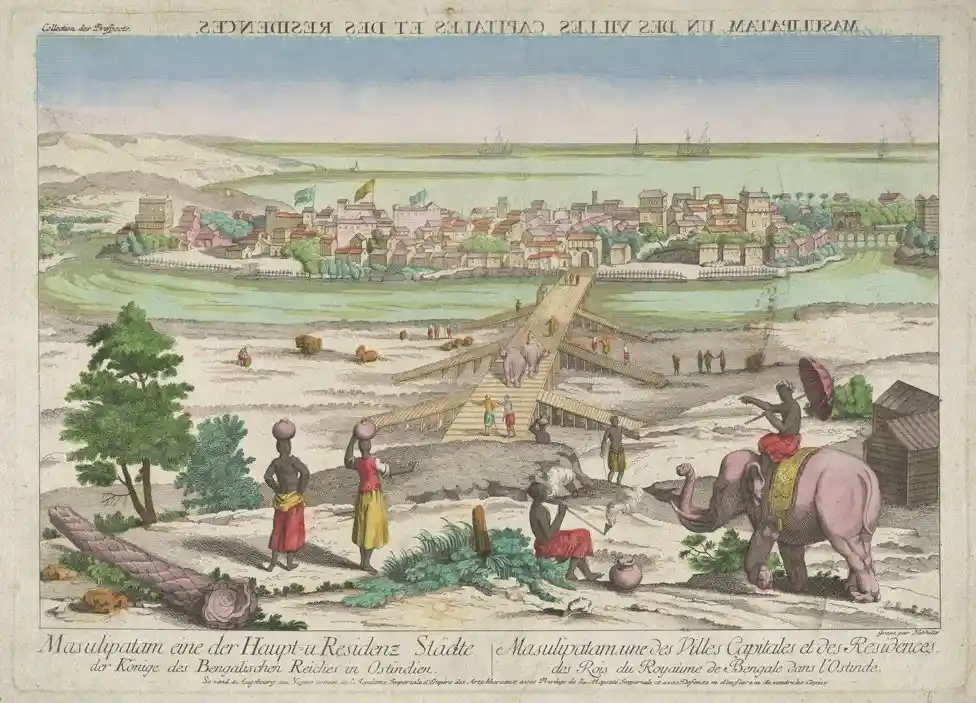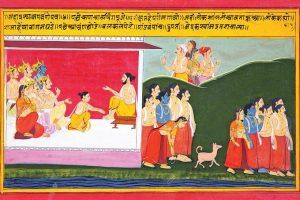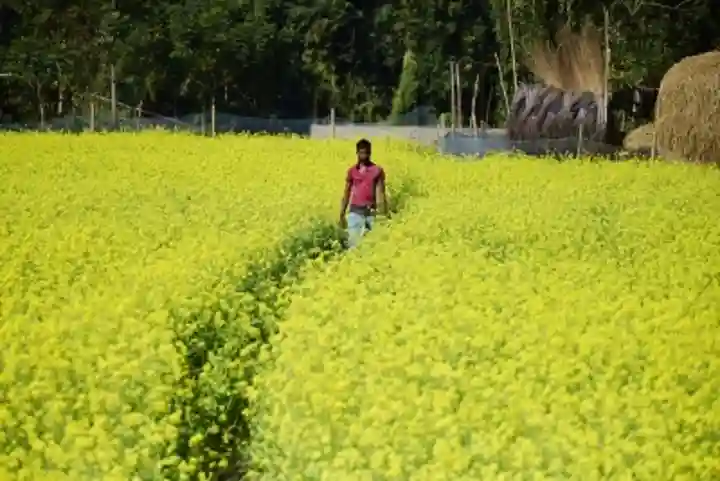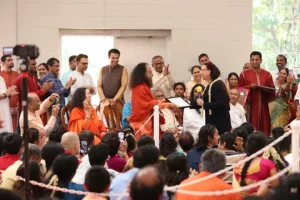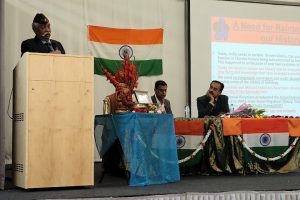With interest in India’s culinary culture at an all-time high, it is now amply clear to audiences both domestically and globally that “curry” does not exist in Indian cuisines. Instead, it is a colonial construct—the result of a western gaze upon Indian culture, and cooking. But how did this “curry” that dominated western minds and palates for so long standing in for a definitive if false idea of Indian food come about in the first place? What is the origin of the term? And of various recipes that are at best a mishmash of spices without nuance?
The word curry –and a recipe for it– first appears in a 1747 cookbook; the recipe including turmeric, pepper, ginger, onion and salt. This is a rather simple recipe and something that may have gone into stir-fried meats or vegetables in many parts of the country. But this simplistic curry that incorporates turmeric and ginger, two of the oldest spices and herbs in the Subcontinent (the remnants of a brinjal preparation excavated from an Indus Valley site have both turmeric and ginger in it)is a far cry from the later-day curry and curry powder mixes that started appearing with great regularity by the end of the 18th century in Britain and amongst the Anglo Indian communities of Colonial India.
At the beginning of the 19th century, curry powder was gaining in popularity in the UK, as an elite, expensive imported ingredient. An advertisement by John Caird, a Scottish grocer in 1798, for instance, one of the earliest for curry powder in the UK, beckons the public to come buy a stash of “real Indian curry powder” that had just arrived in Scotland. It is to be noted that a chunk of soldiers and clerks joining the English East India Company came from the impoverished gentry of Scotland. Stories of traders and Indian “nabobs” earning fabulous riches were gaining ground and young men with few prospects were increasingly attracted to the Indies. They came back with a taste for “curry” and curry powder started gaining popularity in elite circles in Europe.
In fact, the Scottish love affair with the curry abides till today and is evident in the huge number of curry houses in cities such as Edinburgh —as also in some of their fusion dishes.
I make my own curries. In Scotland we have Indian Restaurants on almost every corner downtown. Pub. Curry. Home 😂😂😂
Love them so much learned to make them myself.
My curry bible. This book is amazing. pic.twitter.com/fpMu1SUb61— Catherine #https://openvaet.org (@i_ourpatio) April 19, 2018
One January, on a visit to Scotland, as I sat in the only restaurant in a small village called Tain near Inverness not far from the intriguing Fyrish monument, built by General Hector Munro (who served as the ninth commander in chief for the EIC in Bengal from 1764 to 1765), ostensibly to resemble the gates of Nagapattinam, near Madras (the port was conquered by the East India Company in 1781 under the command of Munro and Edward Hughes), I found myself confronting some Scottish curry flavoured haggis-on-toast.
It was Burns Night Supper, commemorating Robert Burns’ poetry, when the entire village had turned up in their festive best—men in kilts, women in gowns. For most of them, I was the only Indian they had ever encountered. However, the appetiser—curry flavoured haggis on toast—that all of the local populace was celebrating as its own did have an India connect.
Tonight is Burns Night! 🥃
Join the celebrations with a Burns supper, whisky and, of course, the poetry of the man himself…🖋️❤️
📷 1: IG/travellingtwo_
📷 2: VisitScotland/Luigi Di Pasquale#LoveGreatBritain #CelebrateBurnsNight pic.twitter.com/M4SOGfWO7P— VisitBritain 🇬🇧 (@VisitBritain) January 25, 2022
Curry powder that goes into many British preparations is indeed a British invention, or even Scottish. But it comes from the 18th century fascination that soldiers and “factors” of the East India Company present in southern India had with local south Indian cuisines.
In Telugu cuisines of Telangana, coastal Andhra and Rayalseema regions, one of the most ancient dishes is something called the “koora”. A koora is in essence a dish with gravy. Fried or stir fried food dishes are not called koora. Within this broad classification of spiced gravied koora, the iguru is a semi dry spicy, hot preparation, while a more liquid gravy made with tamarind is called pulusu, as my friend and well-known educationist Kerron Reddy of the AIMS Institutes tells me. Chepala pulusu, the most touristy of Andhra dishes is thus a sour, tamarind-laced fish gravy. But the koora is the mother of these classifications. And possibly, the genesis of the English “curry”, quite clearly a corruption of the Telugu term.
Our next stop is #AndhraPradesh.A land of #rich #delicacies like #HyderabadiBiryani, Panasa Pottu Koora, and many more. pic.twitter.com/RRxp0X0ncQ
— Courtyard Ahmedabad (@CYAhmedabad) July 22, 2017
In fact, the ancient port of Masulipatnam on the Andhra coast of the Bay of Bengal may have played a role in the gradual popularity of “curry” in 18th century Britain, and the gradual development of the curry powder in the 19th century from the dish, as a quick method to add heat and tanginess to anything.
Students of history may already know that the English East India Company had established one of its earliest factories at the old port of Masulipatnam in 1616, where its factors (traders) stayed, though the port was then held by the French and the Dutch from 1686 to 1759.
Masulipatnam had its heyday under the Qutb Shahi kings of Golconda in the mid 17th century. By the end of the 17th century, as the Mughals conquered it, it fell into disrepair but by then, the East India Company had a well established presence in the south, including its first fort to defend its trading interests at Fort St George in Madras.
If you do visit Andhra Pradesh, plan a visit to Masulipatnam & sit on the shores & imagine the sounds & colours of 2000 years of merchants and cherish this great heritage that once was
RT if you liked this history tour & share with your friends
Follow @myhistorytales for more! pic.twitter.com/p04CLQkqrf
— A History a Day (@myhistorytales) March 11, 2022
Madras “curry” that took its name from the spicy and sour preparations of the eastern coast of southern India where the Europeans jostled for influence and trade through the 17th and 18th centuries thus became a sort of short hand for Indian food as these India hands, both merchants and soldiers returned home. But slowly, as larger parts of the subcontinent started falling to the military and therefore political might of the colonials, even in the European mind, some semblance of the distinctiveness of regional cuisines in India started taking shape.
By 1895, a century and a half after the first basic “Indian curry” recipe had been published, we find Henrietta A Hervey, the wife of a retired officer, giving elaborate curry powder recipes in her book “Anglo Indian Cookery At Home”, written for old India hands who had returned to England. These curry powders are named after the three presidencies—Madras, Calcutta and Mumbai. How to make Madras curry paste is a distinct recipe from that of the Madras Curry Powder that can be bottled and stored for long term use. Instead of turmeric, the Madras Curry powder by this time, gets saffron in the spice mix, as also many more red chillies (introduced by the Portuguese by this time) than in say the Bombay curry powder. Instead of tamarind that was a feature of the Andhra and other eastern-southern gravies, the Madras curry paste now has vinegar, used by the Europeans but not Indians in their home cooking. And the mix of spices—around 10-12, but without any complex garam masala aka javitri, jaiphal, pathar ke phool, khus ki jad et al used in many Indian cuisines—is arbitrary at best showing a complete lack of understanding of Indian regional cooking within homes.
In the UK, the “Madras” is still popular—standing for something hot, dark orange and sour. Post Independence, as immigrants from the Subcontinent opened “Indian” restaurants in the UK, they tried to develop a scale of hotness for the various curries they were offering so that it became comprehensible to their British audience—so while a Madras was hot, a korma was sweet and mild. The stereotypes have persisted till today, though now are on their way out.
The British curry inspired by the Andhra koora and the tastes of southern India also travelled to other parts of the globe. “Curries” in Thailand, for instance, bear the Indian imprint—not just from ancient times but more modern post-Vietnam times when the “kaeng” (there was no curry in Thailand too) became the curry thanks to American and European tourists propagating the stereotype. In Japan, “kare” rice was also a 20th century “western” dish brought by the English navy to the island. But how Indian food was appropriated by the colonial presence and exported to other parts of the world where its influence could be felt is a story for the next column.
Also Read: How colonial Britain bungled in viewing diverse Indian cuisine as a mere ‘curry’






